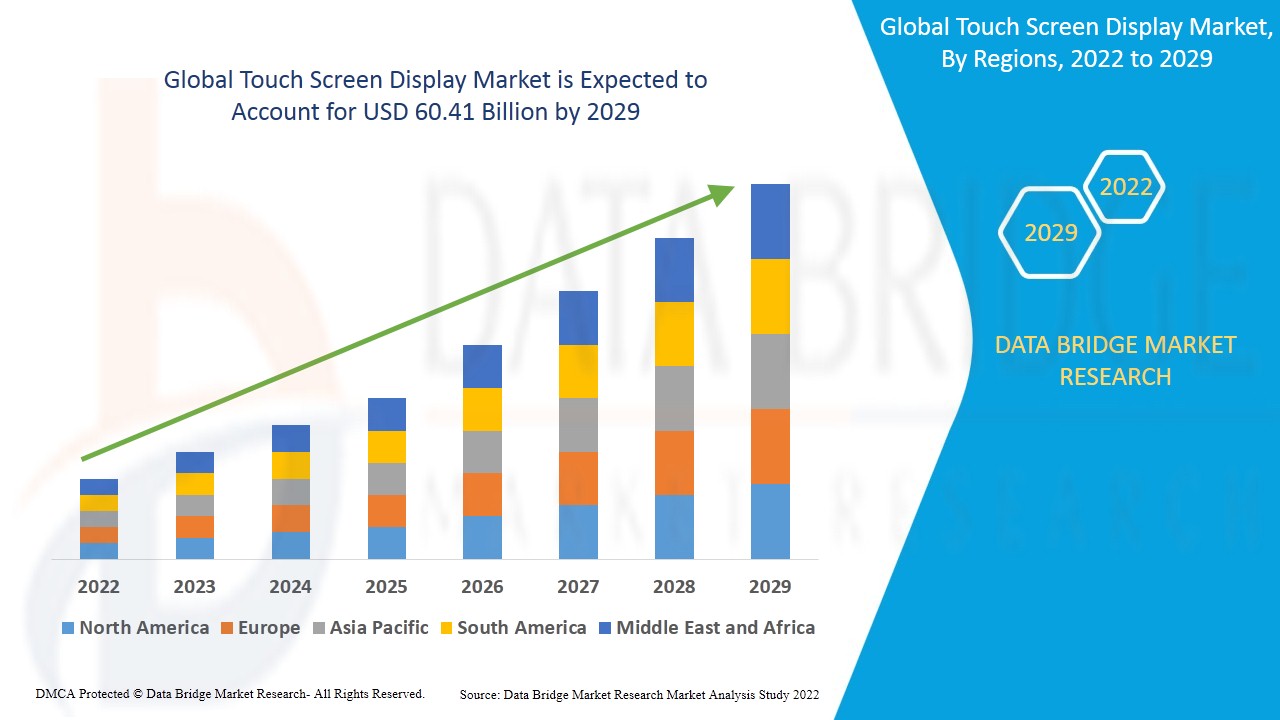Introduction
The touch screen display market has undergone a transformative journey over the past two decades. From rudimentary resistive touch panels to today’s ultra-responsive, multi-touch capacitive displays, touch technology has evolved into an indispensable component across numerous industries. As digital interfaces continue to dominate modern consumer experiences, touch screen displays are being increasingly adopted in smartphones, tablets, kiosks, automotive dashboards, industrial machines, smart appliances, and more.
This article explores the current landscape of the touch screen display market, analyzing its growth drivers, challenges, technological innovations, and future prospects.
Market Overview
The touch screen display market is witnessing exponential growth, driven by the global digitalization wave and the demand for intuitive human-machine interfaces (HMIs). The market includes a variety of technologies such as capacitive, resistive, infrared, surface acoustic wave (SAW), and optical touch. Among these, capacitive touch screens dominate due to their superior responsiveness, clarity, and multi-touch capability.
According to recent market studies, the global touch screen display market is projected to surpass USD 100 billion by 2030, expanding at a compound annual growth rate (CAGR) of over 8% from 2023 to 2030. The growth is being propelled by the increasing penetration of smartphones and tablets, expanding automotive infotainment systems, rising use of digital signage, and surging demand in healthcare and retail sectors.
Key Market Drivers
1. Smartphone and Consumer Electronics Boom
The proliferation of smartphones and tablets remains the largest driving factor for the touch screen display market. With billions of devices in circulation globally, manufacturers are constantly innovating to deliver better resolution, edge-to-edge designs, and responsive touch features.
2. Growth of Interactive Kiosks and Digital Signage
Retailers, transport hubs, and public service sectors are increasingly investing in interactive kiosks and digital signage to enhance customer experience. These systems rely on high-quality touch screens to offer services like self-checkout, information browsing, and ticketing.
3. Automotive Infotainment and Navigation Systems
Modern vehicles now feature large, interactive dashboards that rely heavily on touch screen displays for navigation, media control, and vehicle diagnostics. The automotive industry’s shift towards connected and autonomous vehicles further augments the demand for touch-enabled interfaces.
4. Healthcare Applications
The healthcare sector utilizes touch screen displays in diagnostic devices, patient monitoring systems, and hospital information terminals. The COVID-19 pandemic accelerated the use of contactless and hygienic touchscreen solutions, further boosting market adoption.
5. Industrial and Commercial Automation
Touch screens are now a standard in industrial automation for controlling machinery, managing workflows, and monitoring systems. Their durability and adaptability in harsh environments make them ideal for manufacturing floors and logistics centers.
Technological Advancements
1. Flexible and Foldable Displays
With advancements in OLED technology, flexible and foldable touch screen displays are gaining traction, particularly in the smartphone and wearable segments. These innovations enable compact device designs without compromising on screen size.
2. Haptic Feedback Technology
To mimic the sensation of physical buttons, haptic feedback is being integrated into touch screens. This tactile response improves usability, particularly in automotive and industrial applications.
3. In-Cell and On-Cell Touch Technology
These technologies integrate touch sensors within the display itself, resulting in thinner, lighter devices with improved responsiveness and clarity.
4. Anti-Reflective and Anti-Fingerprint Coatings
To enhance visibility and hygiene, new coatings are being developed to reduce glare and prevent smudging, especially in high-traffic public touchpoints.
Challenges in the Market
Despite its promising outlook, the touch screen display market faces several challenges:
1. High Cost of Advanced Technologies
While capacitive and OLED touch displays offer superior performance, they come at a higher cost, which may hinder adoption in price-sensitive markets.
2. Durability and Damage Risk
Touch screens, especially in mobile and outdoor applications, are prone to scratches, cracks, and damage, necessitating the use of protective layers or cases.
3. Complexity in Integration
Integrating touch screens into certain devices, especially in rugged or compact applications, poses design and engineering challenges.
4. Environmental Concerns
The production and disposal of touch screens contribute to electronic waste. Sustainable materials and recycling methods are needed to reduce the environmental impact.
Regional Insights
1. Asia Pacific
Asia Pacific dominates the global market, with China, South Korea, and Japan leading in both manufacturing and consumption. The region’s dominance is supported by the presence of major players like Samsung, LG Display, and BOE Technology.
2. North America
North America is a mature market, driven by high consumer electronics penetration and demand from healthcare, automotive, and retail sectors. Technological innovation and R&D investments also keep the region at the forefront.
3. Europe
Europe shows steady growth, particularly in automotive applications and industrial automation. Stringent regulations and emphasis on energy efficiency and quality boost innovation in the region.
4. Latin America, Middle East & Africa
These regions are experiencing moderate growth, fueled by digital transformation in retail, education, and public services.
Competitive Landscape
The touch screen display market is highly competitive with several global and regional players:
- Samsung Display Co. Ltd.
- LG Display
- BOE Technology Group
- Sharp Corporation
- AU Optronics
- Fujitsu Limited
- Corning Incorporated
- TPK Holding Co.
These companies focus on R&D to develop new technologies, reduce manufacturing costs, and enhance product features.
Future Outlook
The future of the touch screen display market looks promising, with innovations in materials, AI integration, and seamless user experience. Voice and gesture controls may complement rather than replace touch interfaces, creating hybrid systems for enhanced interactivity.
Emerging applications in augmented reality (AR), virtual reality (VR), smart wearables, and edge computing devices will continue to open new avenues. Additionally, the push toward sustainability will influence the development of eco-friendly and recyclable touch screen materials.
Conclusion
The touch screen display market is a dynamic and rapidly evolving space that is redefining how humans interact with machines. With continued technological innovation, expanding applications across industries, and rising consumer expectations for seamless digital experiences, the market is poised for sustained growth. Companies that prioritize user-centric design, durability, and innovation will remain competitive in this vibrant landscape.
Read More Details : https://www.databridgemarketresearch.com/reports/global-touch-screen-display-market
